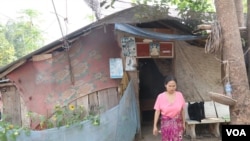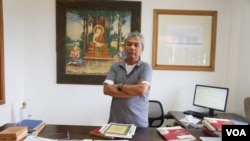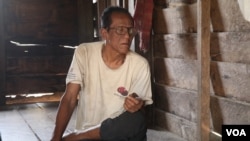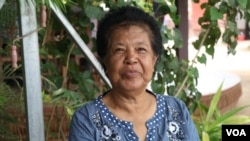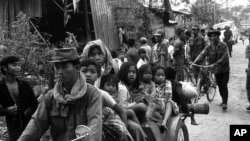On a recent morning, a young Cambodian mother was taking her toddler for a stroll on a small trail off the main road in Choam Sa-Ngam, a small town perched atop the Dangrek Mountain Range.
The town’s main feature is a hulking, gaudy casino built next to the border checkpoint with Thailand to the north, while its elevation offers splendid views of the Cambodian plains below that stretch south as far as the eye can see.
Yet, the historic site this town in northwest Cambodia is best known for is poorly maintained and appears almost ignored by its residents. A two-meter-long mound of dirt shielded from the sun by a rusty tin roof and surrounded by a decrepit fence is the final resting place of the country’s most notorious leader: Pol Pot.
Some twenty years ago, on April 15, 1998, the Khmer Rouge leader whose reign of terror cost the lives of an estimated 1.7 million Cambodians, died of apparent heart failure at 73. His fellow cadres, who by then had turned on him, unceremoniously cremated his corpse here with his personal belongings on a pile of old car tires.
Taking her eyes of her playful toddler and glancing at the nearby site for a moment, Seng Ra, 27, said she found it a bit odd that the infamous leader’s resting place looked more like a simple goat’s pen.
“I thought he was a type of national leader that was would typically be put to rest in a fancy tomb or stupa,” she said, before shrugging.
A battered old sign reads ‘Pol Pot was cremated here.’ A collection of burned incense sticks at a makeshift altar indicates that the ghost of the man whose memory still haunts Cambodia retains some powers in the eyes of some visitors, who believe it needs to be shown respect.
Seng Ra, who moved here with her family when she was 11 years old, has no conscious memories of the Khmer Rouge in Oddar Meanchey province’s Anlong Veng district, a former stronghold where the last cadres held out under commander Ta Mok until their surrender in December 1999.
“Some people said Pol Pot is bad, while some others here suggest he was fine,” she said, adding that her mother had told her she suffered many hardships during the 1975-1979 Democratic Kampuchea regime.
Trauma lingers
Mao Saroeum, 63, is unequivocal when it comes to Pol Pot’s impact on her life and country. “He left us nothing but pain and family separation,” she told VOA at her home in Deum Kor village on Phnom Penh’s outskirts.
She lived in Kandal province with her husband, who was a medic, and their two children when the Khmer Rouge took over. He was killed at Po Tonle prison in Kandal and she and her children were sent to a farming collective in Battambang province. She is the only who survived.
“There was nothing to eat. It was very difficult. We were forced to work up to 15 hours a day in the rice fields and we cleared forests to make way for new farmland,” said Mao Saroeum, who remarried in the 1980s and has five children.
“When I learned about Pol Pot’s death on the radio my first thought was: die off!” she recalled when asked about hearing of his demise 20 years ago.
Like for Mao Saroeum, the trauma inflicted by Pol Pot continues to affect Cambodia, as have decades of poverty and political violence that followed the collapse of his rule.
To this day, many Cambodians also struggle to come to a full understanding of his regime due to limited public information and the lack of an open, nationwide dialogue about the past. Local reconciliation has suffered in the absence of a broad process of transitional justice, and it is not uncommon for alleged perpetrators to live in villages near their victims.
Youk Chhang, executive director of the Documentation Center of Cambodia, said public education about Pol Pot’s regime remains necessary to help people accept the truth about past horrors and come to a shared understanding about what happened.
“Khmer Rouge history is a journey of understanding between friend and enemy, and they should continue the journey,” said Youk Chhang, whose center has long organized schools curriculums and community events about the regime and which supports the public attendance of the United Nations-backed Khmer Rouge Tribunal.
38 years of bloody leadership
Born as Saloth Sar to a wealthy farmer, Pol Pot studied at Cambodia’s elite schools before picking up some of his radical communist notions while studying in Paris in the 1950s. He returned to Cambodia and lead to movement from 1963, adopting his nom de guerre Pol Pot. He was known in the regime as ‘Brother No. 1’.
During the late 1970s, he and his senior comrades like Nuon Chea, Ieng Sary, Khieu Samphan and Ta Mok, subjected Cambodian society to an extreme Marxist-Maoist ideology. Cities where emptied, private property abandoned and all people were forced to work in farming collectives.
Some 20 percent perished from starvation, while countless people were abused and murdered, especially those considered members of the urban classes. Extreme Khmer nationalism justified the regime’s attacks on Vietnam and the mass killings of ethnic Vietnamese and other minorities.
Journalist Elizabeth Becker interviewed Pol Pot at the height of his power in 1978, an experience she described in a BBC article: “He ranted and raved about the impending Vietnamese invasion - always in the quietest of tones... There was no interrupting. There were no questions about the condition of the Cambodian people, about the executions and killing fields. Pol Pot's vision had no room for anything but enemies and justification of his behavior.”
After being ousted by the invading Vietnamese army in 1979, the Khmer Rouge fell back on the jungles of the northwestern border region, where Pol Pot continued to ruthlessly lead the movement in characteristic deep secrecy.
By the late 1980s, it had become part of a loose alliance of anti-Vietnam forces led by Prince Norodom Sihanouk and supported by Thailand, the West, and China, until a peace accord was reached with Vietnam and the Vietnam-backed Hun Sen government in 1991.
The Khmer Rouge, which still had tens of thousands of soldiers, resumed attacks in the 1990s, but their strength dwindled and half of the forces defected in 1996. On 10 June 1997, in the last bout of violent paranoia, Pol Pot ordered the murder of his longtime commander Son Sen and his family for seeking a settlement with the government. Nine days later, Ta Mok ordered Pol Pot arrested and put him on a show trial to distance the collapsing movement from its leader.
No remorse, no justice
In October 1997, The Far Eastern Economic Review’s Nate Thayer managed to interview Pol Pot in Anlong Veng district in what was only the second and last interview the leader ever gave.
In the interview, still available on Thayer’s personal website, Pol Pot showed no remorse over the countless deaths he caused. “Everything I have done and contributed is first for the nation and the people and the race of Cambodia,” he said, “My conscience is clear.” Pol Pot claimed “mistakes” had been made during the revolutionary struggle that leads to deaths, but that without the movement Cambodia would have been annexed by Vietnam.
Some six months later, Thayer was invited to view Pol Pot’s corpse. Khmer Rouge cadres said he had died from heart failure shortly after listening to a VOA Khmer radio broadcast (to which Pol Pot reportedly listened frequently) carrying a news report, originally from Thayer, that he would soon be handed over to an international court.
At the time, Ta Mok denied to the Associated Press that Pol Pot had been murdered, but mocked his longtime boss in death, saying, “Now he is finished, he has no power and no rights any longer. He is nothing more than cow dung. Actually, cow dung is more useful because it can be used as a fertilizer.”
Pol Pot had one child from his second marriage to Mea Son in 1986. His daughter Sar Patchata, 30, and wife live in Banteay Meanchey province.
Through his death Pol Pot escaped justice for his crimes against humanity and so did Ta Mok, who died in detention in 2006. Only four ex-Khmer Rouge leaders were jailed in 2007 and eventually sentenced in a long-running proceeding at the $200-million, the UN-backed tribunal in Phnom Penh.
The decision to prosecute only a handful of former leaders was the result of a compromise between the UN and Prime Minister Hun Sen’s long-ruling government, which resisted an effort at wider transitional justice.
‘Too extreme’
At Choam Sa-Ngam town, few former cadres remain and most residents moved here after the civil war ended.
Dy Sam On, 70, fought against the Khmer Rouge in the 1970s as a soldier for the short-lived Khmer Republic of General Lon Nol. His parents and all siblings were killed when the Khmer Rouge took over, but he maintains a surprising level of understanding for Pol Pot’s ideological thinking.
“I hate him… Yet he had a good point as he brought discipline for a clean society: there were no thieves, no smugglers, no prostitution, but he was too extreme and millions were killed,” Dy Sam On said.
Yeay Ouk, a 63-year-old ethnic Vietnamese woman also known as Le Thi Thu Cuc, moved to the village shortly after the fall of the Khmer Rouge, hoping that the newly opened frontier areas would offer economic opportunities.
Yeay Ouk left the Mekong Delta in the 1990s to come to Cambodia and in the past, she feared the Khmer Rouge, but now the movement is simply part of the local history. Her daughter is married to a former cadre and, like some other elderly villagers who maintain traditional ancestor worship practices, she even pays respects to his ghost at the decrepit cremation site.
“I live in his area, so I have to respect him… we respect the dead like we respect our parents,” she said. “Once in a while, I drop by his grave to pray for happiness for my children.”
Ex-cadres defend Pol Pot
Some elderly former cadres who fought alongside Pol Pot still maintain he had the right intentions.
Yong Moeun, 71, joined the Khmer Rouge in 1965 when she was still in high school and accompanied Pol Pot for much of his life, often cooking his meals for him from scarce ingredients and wild animals available at their jungle bases.
She described him as hardworking and quiet, while occasionally displaying an odd sense of humor. “Pol Pot loved making jokes by saying the opposite thing. For example, if the food we cooked was a bit salty, he would say the food was watery,” she recalled.
Yong Moeun - whose late husband Pich Cheang was Democratic Kampuchea’s top diplomat in China, the regime’s main backer - now lives just outside Siem Reap.
She told VOA that Pol Pot had been a “patriot” with a “vision of protecting the nation and the (Khmer) race,” though she acknowledged that as its leader he carried responsibility for the regime’s wrongdoings.
“What went wrong is on him. (But) I know that he couldn’t control everything and to identify all who were good and who was bad,” she said, implying that Pol Pot was not fully culpable for the 1970s horrors.
At Pol Pot’s native village of Prek Sbauv, near Kampong Thom town in northeast Cambodia, lives his niece, Nhep Thul, 54. She said she never met her infamous uncle and had suffered in the same way as other Cambodians during the regime’s nationwide collectivization experiment
“I only saw him in pictures and on television. I have never cared about it,” she told VOA reporter who recently visited her village. “I think he was a good guy, but I don’t know why he acted the way he did - it was politics and I didn't know about it.”
Her daughter, Tin Chanthou, said she was uncomfortable with her family history. “I never tell anyone about it,” she said.
Becker, the journalist, told VOA that Pol Pot’s rule offers one important, overarching lesson for Cambodia that resonates in the current political environment, where the Hun Sen government banned the main opposition party and jailed its leader last year.
“The lesson is that a single person and a single party that amasses total power will ruin Cambodia. Unchecked power leads to corrupt leaders, indiscriminate killing to keep control and denial of basic rights. No society can flourish under such a ruler,” Becker said.
Additional reporting by Khan Sokummono





